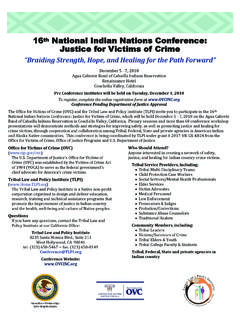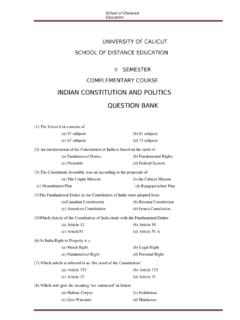Transcription of Indian Law Enforcement History - Tribal Law and Policy ...
1 Indian Law Enforcement History 1 Indian Law Enforcement History The following Bureau of Indian Affairs document can be found in its entirety at: Indian Law Enforcement History 2 PREFACE Whether it be achieving the peaceful arrest of Geronimo and his heavily armed followers in the 1870's, stopping the liquor traffic in the Indian Territory just after the turn of the century, or maintaining the peace in the emotionally charged atmosphere of the Dakotas in the 1970's, the work of the Indian police has always been challenging.
2 The Indian police carry with them a long and distinguished tradition that provides the inspiration to meet the challenges they face. It extends not merely to the creation of the reservation system, but back into the unrecorded histories of the Native American societies before the white men came. Many of the men who answered the call to service in the 1870's were already veterans in police work with the police societies of the Plains tribes or the office of High Sheriff of the tribes of the Indian Territory. Likewise, the first judges selected were often men with distinguished records as leaders of their people.
3 Some, like Quanah and Gall, had been leaders in the fierce Indian resistance to white encroachment. When they saw conditions had changed, they chose again to lead their people and help them make the best of the new world. This short History of the Indian Criminal Justice system is dedicated to the men and women whose goal it is to carry on this heritage as they work each day to bring the peace, justice and safety so important to the continued development of the communities we serve. You may notice this document only covers our History up to 1975, and many dramatic changes have occurred since then.
4 When time and resources permit we fully intend to update this section. Theodore R. Quasula Director, Office of Law Enforcement Services Indian Law Enforcement History 3 A Short History of Indian Law Enforcement "I have appointed a police, whose duty it is to report to me if they know of anything that is wrong." 1 With those words Thomas Lightfoot, United States Indian Agent to the Iowa and the Sac and Fox tribes in Nebraska, became the first agent to report the establishment of a Federally-sponsored Indian police in 1869.
5 Agent Lightfoot's action was his response to a major shift in United States Policy toward the indians . Europeans from the time of their first arrival, had dealt with Indian tribes as sovereign nations. When the Europeans wanted more land, they forced tribes to sign treaties agreeing to move out of the way. When there was no place else to go, the tribes were forced to agree to reserve only a small part of their lands for their own use. As the white population in Indian country grew, many people began to believe the Government should deal with indians as individuals rather than as sovereign tribes.
6 Commissioner of Indian Affairs Ely S. Parker expressed this view in 1869 when he urged an end to treaty-making: "..because treaties have been made with them, generally for the extinguishment of their supposed absolute title to land inhabited by them or over which they roam, they have been falsely impressed with the notion of national independence. It is time that this idea should be dispelled and the government cease the cruel farce of thus dealing with its helpless and ignorant wards." 2 Four years later, Commissioner Francis A.
7 Walker recommended a new Policy to replace the treaty approach: "The reservation system affords the place for thus dealing with tribes and bands, without the access of influences inimical to peace and virtue. It is only necessary that Federal laws, judiciously framed to meet all the facts of the case, and enacted in season, before the indians begin to scatter, shall place all the members of this race under a strict reformatory control by the agents of the Government." 3 Indian Law Enforcement History 4 To implement this Policy , Commissioner Walker urged the continued use of the military: "Such a use of the military constitutes no abandonment of the peace Policy and involved no disparagement of it.
8 It was not to be expected--it was not in the nature of things-- that the entire body of wild indians should submit to be restrained from their Ishmaelitish proclivities without a struggle on the part of the more audacious to maintain their traditional freedom."4 There were many persons concerned with Indian Affairs who agreed with Commissioner Walker that indians should be "reformed" but did not believe the Army should be used to do it. Walker's successor, Edward P. Smith, also urged the use of the military amount the Sioux in his first annual report in The following year, however, he recommended that deputy Marshals be used to enforce law among the In the meantime, Agent Lightfoot and others improvised their own solutions to the problem.
9 In 1872, Special Indian Commissioner for the Navajos, General Howard, organized a cavalry of 130 Navajos to guard reservation boundaries, arrest thieves and recover stolen The force was successful in recovering 60 head of stock in three months and continued in existence despite orders from Washington that it be In 1874, the San Carlos Reservation Agent, John Clum, wanted to control both the Apaches and the Cavalry. Clum's predecessors had complained that the reservation was under military control. Agent Clum was determined to change that.
10 He knew he could not assert his independence from the military while depending on it to keep the peace. His answer was to hire four apaches at $15 a month as police. Two months later he asked the military to leave. The military did not oblige, but Agent Clum did manage to function without military The police force grew to 25 including Clay Beauford, a Virginian he hires as police chief. The police were establishing themselves in the Plains at the same time. The satisfactory operation of forces among the Winnebago s, and the Santee and Red Cloud Sioux led Commissioner Edward P.











